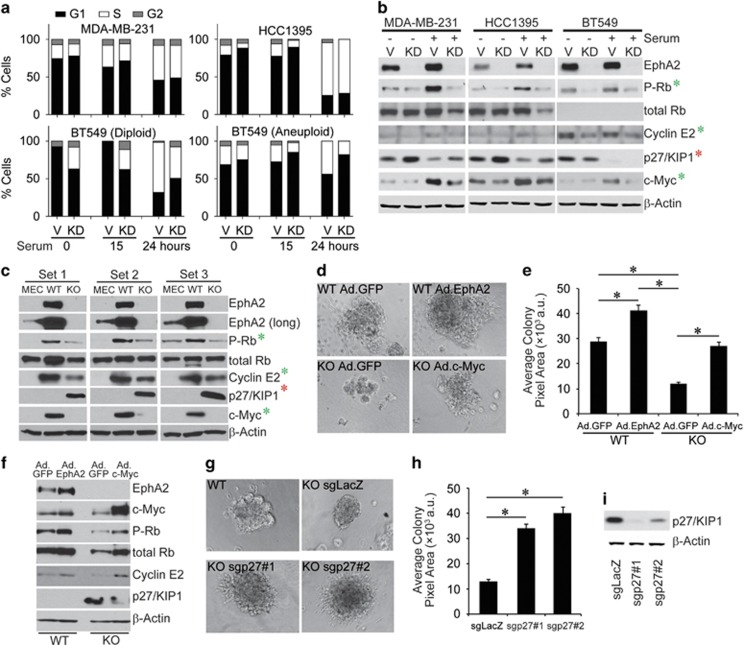Figure 5.
EphA2 loss impairs cell cycle progression through S-phase in TNBC cells. (a, b) MDA-MB-231, HCC1395 and BT549 vector control (V) and EphA2 shRNA knockdown (KD) lines were starved then serum-stimulated for 0, 15 or 24 h prior to propidium iodide labeling and FACS analysis for DNA content. (a) All three human shEphA2 knockdown lines showed a general decrease in the percentage of cells in S-phase relative to vector controls: MDA-MB-231 at 15 h post serum stimulation, HCC1395 at 0 and 15 h post serum stimulation, and aneuploidy BT549 at 0, 15 and 24 h post serum stimulation. (b) Immunoblot analysis of S-phase cell cycle regulators in vector (V) control versus EphA2 shRNA knockdown (KD) human TNBC lines under basal (serum-starved, −) conditions versus stimulation with serum (+) for 15 h; (c) and three independent isolates of wild-type (WT) and EphA2-deficient (KO) C3-TAg cells versus primary mouse mammary epithelial cells (MEC). We observed decreased levels of P-Rb, c-Myc and cyclin E2 (green *) and increased expression of p27/KIP1 cell cycle inhibitor (red *) in KD and KO cells relative to controls. Data were from three independent experiments. (d, e) Adenovirus-mediated overexpression of EphA2 (Ad.EphA2) significantly increased colony size of wild-type (WT) C3-TAg cells in three-dimensional spheroid culture relative to adenovirus GFP (Ad.GFP) control (*P<0.05, Student’s t-test). Overexpression of adenovirus c-Myc (Ad.c-Myc) in EphA2-deficient (KO) C3-TAg cells rescued three-dimensional spheroid growth to near wild-type levels relative to Ad.GFP controls (*P<0.05, Student’s t-test). (f) Immunoblot analyses confirmed EphA2 or c-Myc overexpression as well as modulation of P-Rb, cyclin E2 and p27/KIP1 in WT and KO C3-TAg cells. (g, h) Stable knockout of p27/KIP1 by two independent guide RNA sequences also rescued growth of KO C3-TAg cells in spheroid culture. (i) Immunoblot analysis confirmed p27/KIP1 knockout. N=three independent experiments/condition with triplicate biological replicates, (*P<0.05, Student’s t-test).

